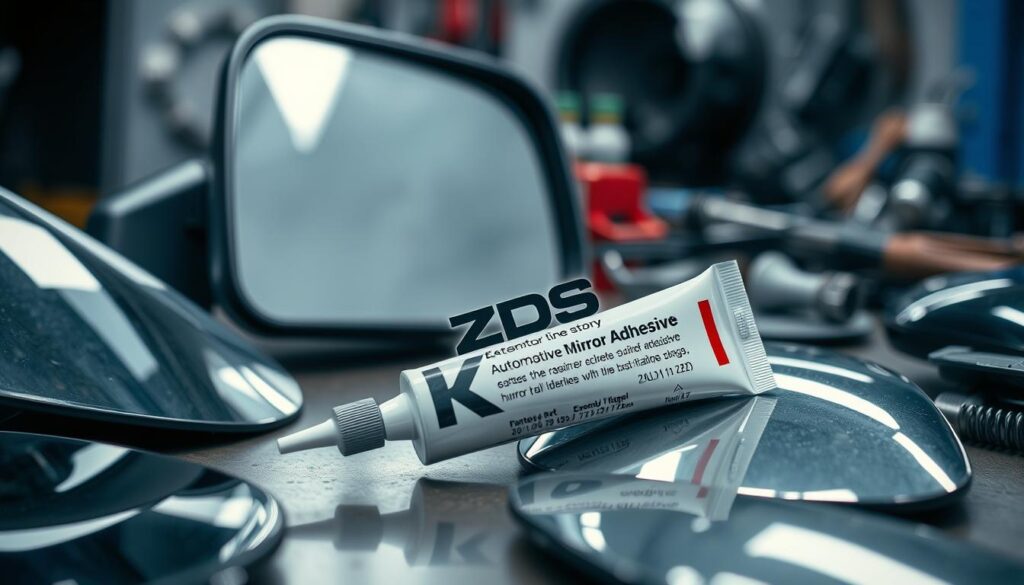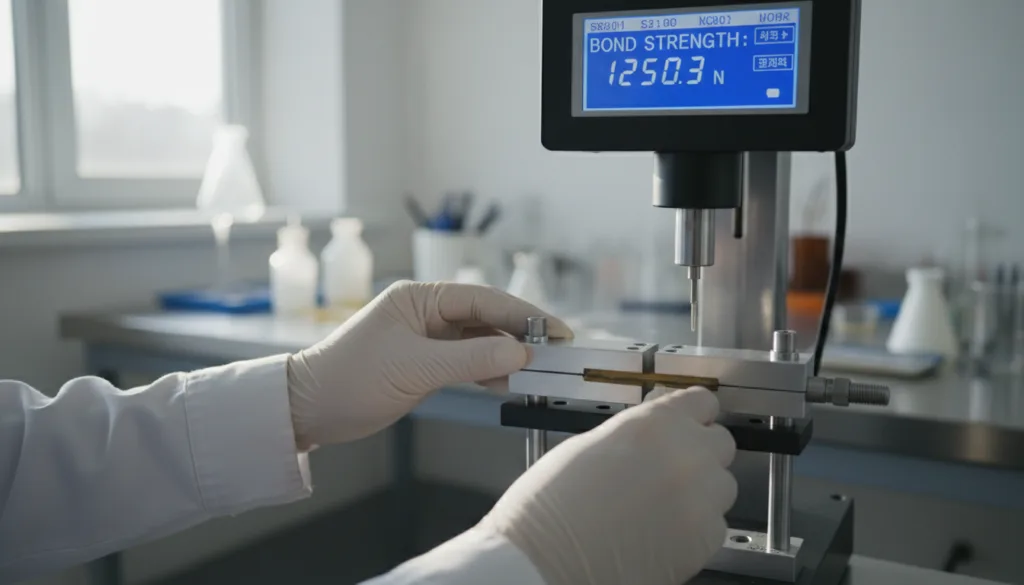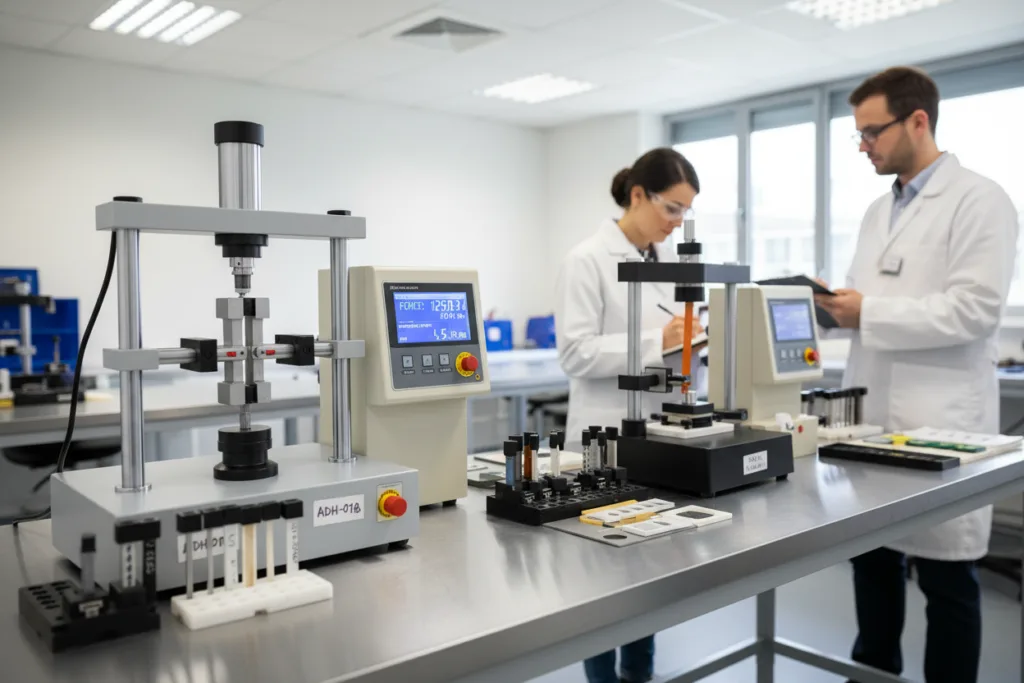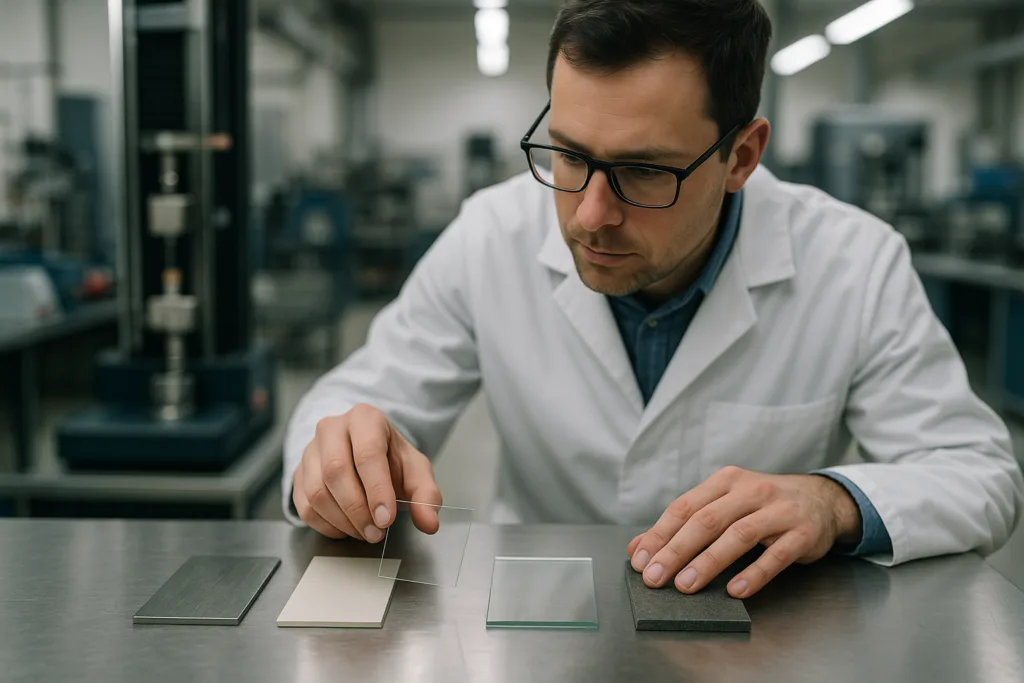Choosing the right adhesive is key in automotive repair. This guide is for car lovers and pros. It focuses on the best mirror adhesive for glass and metal. We stress quality and detail how these adhesives create a lasting bond. Understanding how to bond glass and metal is vital. We make the details clear, sharing pro tips and new solutions for your adhesive needs.
Key Takeaways
- Understand the importance of selecting the right automotive mirror adhesive for glass and metal.
- Learn about different types of mirror adhesives suitable for cars.
- Discover properties that make a strong adhesive for mirrors reliable.
- Follow step-by-step instructions for applying and removing automotive adhesives.
- Recognize when to utilize repair adhesive for automotive mirrors.
- Stay informed about safety precautions when using adhesives.
Understanding Automotive Mirror Adhesive
Automotive mirror adhesive is key for keeping mirrors in place in cars. This adhesive’s quality affects the car’s functionality and safety. It’s important to pick the right one that sticks well to glass and metal.
The best adhesive for automotive mirrors works great over time. It stands up to temperature changes, moisture, and vibrations. These features make the adhesive dependable for car mirror mounting.
- High strength to keep the mirror secure, even when there’s stress.
- Temperature resistance for dealing with different weather.
- Speed of cure for fast setup and use.
- Compatibility with glass and metal for various cars.
Knowing these points helps make a better decision. This ensures automotive mirrors are safe and work well.
Types of Adhesives for Automotive Mirrors
Selecting the right adhesive for automotive mirrors is key. Different adhesives have different uses in vehicles. Knowing these types helps manufacturers and DIY enthusiasts choose well.
- Epoxy Adhesives: Famous for their strength and lasting bond, they work on glass and metal. They resist heat and chemicals, perfect for cars.
- Silicone Adhesives: They are flexible and keep out water. Best for mirrors in changing weather, they stretch and shrink but still hold tight.
- Polyurethane Adhesives: They mix strength with flexibility, ideal for rough conditions. Mirrors stay put despite vibrations and bumps.
- Repair Adhesive for Automotive Mirrors: Made for fixing, these adhesives quickly attach loose mirrors back onto glass or metal.
To choose the right adhesive, think about the job’s needs. Consider the environment, vibration, and materials. This will guide you to the best adhesive type.
| Type of Adhesive | Best Use | Properties |
|---|---|---|
| Epoxy Adhesives | Strong Bonding for All Surfaces | Durable, heat-resistant, chemical-resistant |
| Silicone Adhesives | Flexible Applications | Waterproof, flexible, temperature resistant |
| Polyurethane Adhesives | Vibration Resistance | Strong, elastic, durable |
| Repair Adhesive | Reattaching Mirrors | Quick setting, strong bonding for glass and metal |
Understanding adhesive differences means better mirror installations. It brings safety and stability while driving.
Automotive Mirror Adhesive for Glass and Metal
Picking the right adhesive for car mirrors is key. Look for aglass and metal bonding adhesive that stays strong in tough car conditions.
Properties of Effective Adhesives
When hunting for a good mirror glue, focus on:
- Bond Strength: It must be strong to handle shakes and temperature shifts.
- Flexibility: A bit of give in the adhesive aids with temperature changes.
- Cure Time: Pick a glue that sets in your available time.
- Resistance to Environmental Factors: It should stand up to water, sun, and extreme hot or cold.
Choosing the Right Adhesive for Your Needs
To find the perfect mirror glue, think about what you really need. Points to ponder:
- Material Compatibility: The glue must work well with both glass and metal.
- Application Method: Consider user-friendly options like auto mirror fix glue for easier use.
- Specific Usage: Make sure the glue excels in car applications.
- Durability: Aim for a product that’s proven to last in tough conditions.
How to Apply Auto Mirror Fix Glue
Using the right glue can securely attach the rearview mirror to your car. Following a clear process lowers the risk of the mirror coming loose. It also makes sure the mirror stays on longer.
Preparation of Surfaces
Preparing the surfaces well is key for a strong bond. Begin by cleaning the mirror mount and the mirror’s back. Use gentle soap and a soft cloth to remove dirt, oil, or old glue. Rinse them and let them dry entirely. This step ensures the mirror glue works best.
Step-by-Step Application Process
- Gather Materials: Make sure you have everything needed, such as the right mirror glue, a clean cloth, and any tools for the job.
- Apply Adhesive: Put a small amount of glue on the back of the mirror. Spread it evenly with an applicator.
- Position Mirror: Line up the mirror with the mount on the windshield carefully for the best fit.
- Hold in Place: Press lightly for a few minutes so the glue can hold. Be careful not to move the mirror.
- Allow to Cure: Follow the glue’s drying time instructions. Don’t use the mirror until the glue is fully dry.
Common Brands of Car Mirror Mounting Adhesive
Many brands make excellent automotive mirror adhesive for glass and metal. They focus on high-quality, reliable bonding. Each brand designs its adhesive to meet specific needs.
The following table shows a comparison of popular brands and their adhesives:
| Brand | Product Name | Key Features | Application Type |
|---|---|---|---|
| 3M | 3M™ Rearview Mirror Adhesive | Strong bond, easy application | Glass to metal |
| Loctite | Loctite® Rearview Mirror Adhesive | Weather-resistant, quick curing | Glass to glass |
| Permanent | Permanently® Instant Base Adhesive | Industrial strength, versatile | Glass, metal, and plastic |
| Permatex | Permatex® Mirror Adhesive | High strength, shock resistant | Glass to metal |
Each adhesive varies in strength, depending on your mirror’s needs. Knowing each product helps pick the right one for your car. Consider conditions, surfaces, and application ease when choosing.
How to Remove and Reattach Mirrors
Taking off and putting back mirrors might look tough. But with the right focus, it becomes simpler. Make sure to use the proper tools and a special glue for glass and metal. This ensures the mirror stays in place.
Here’s how to get it done right:
- Gather your materials:
- Safety gloves
- Flathead screwdriver
- Repair adhesive for automotive mirrors
- Cleaning solution
- Prepare the mirror: Start by cleaning the area around the mirror. Use a cleaner to get rid of any dust or dirt.
- Remove the mirror: Use the screwdriver carefully behind the mirror. Don’t damage its back. A little push can help loosen it.
- Clean the surface: After taking the mirror off, clean where it was mounted. This makes sure the glue sticks well.
- Prepare the adhesive: Mix and apply the glue for mirrors as per the instructions it comes with.
- Reattach the mirror: Spread the glue on the mirror’s back and press it against the clean spot.
- Let it set: Wait until the glue dries fully. Check the glue’s instructions for how long this takes.
By doing all these steps, we guarantee a strong attachment. We use top-notch glue for glass and metal. This makes sure your mirror stays up for a long time.
| Step | Action | Notes |
|---|---|---|
| 1 | Gather materials | Use safety gloves to protect your hands. |
| 2 | Prepare the mirror | Clean with a non-abrasive solution. |
| 3 | Remove the mirror | Be gentle to avoid damage. |
| 4 | Clean the surface | Ensure it’s free of residues. |
| 5 | Prepare the adhesive | Follow specific mixing instructions. |
| 6 | Reattach the mirror | Press firmly for a strong bond. |
| 7 | Let it set | Wait for the recommended curing time. |
Benefits of Using Strong Adhesive for Mirrors
Using a strong adhesive for mirrors has many benefits. It makes them last longer and work better. These adhesives ensure mirrors stick well, which is crucial for cars.
Some key benefits include:
- Enhanced Durability: They can handle temperature changes and shakes. This keeps mirrors in place for a long time.
- Improved Safety: Firmly attached mirrors reduce the risk of accidents. This makes vehicles safer.
- Ease of Application: Many of these adhesives are easy to use. Both professionals and hobbyists can use them without trouble.
- Versatile Use: The adhesives work on various surfaces, like glass and metal. This makes them useful for many car projects.
When looking for rearview mirror adhesive, choose one made for cars. The best ones are made with special chemicals. These improve how well they stick and last against weather and other factors.
The main point is, these adhesives do more than just stick mirrors. They play a big part in making cars safe and functional. Quality adhesives help both car makers and DIY fans get great results in their work.
Repair Adhesive for Automotive Mirrors: When to Use
Repair adhesive is key for keeping car mirrors in place. It’s needed if mirrors come off because of certain reasons. These include:
- Accidental collisions
- Wear and tear over time
- Environmental factors, such as extreme temperatures or humidity
This glue helps fix your mirrors, making them look and work well again. It works on glass and metal, creating a durable bond. Both professionals and hobbyists find it simple to use and quick to dry.
Having this glue ready is crucial in emergencies to avoid more damage. It lets people fix their mirrors fast and safely return to driving. Its usage across the auto industry proves how effective and necessary good glue is for maintenance and repairs.
Tips for Ensuring a Reliable Bond
Getting a strong bond with automotive mirror adhesive is key for safety and performance. The right methods improve how well glass and metal bond. They make sure your mirrors stay put. Keep these important points in mind.
Temperature Considerations
The temperature affects how mirror adhesive cures on cars. The right temperature range helps the adhesive work better and bond solidly. Think about these points:
- Apply adhesives in a temperature-controlled setting.
- Steer clear of very hot or very cold conditions during the application.
- Let the adhesive warm up to room temperature before using it.
Applying Pressure for Optimal Bonding
Putting the right amount of pressure when curing boosts bond strength. Here are ways to do that:
- Use clamps or weights to press the mirror against the adhesive surface fully.
- Press down firmly but gently to prevent damage to the mirror or where it’s mounted.
- Check the manufacturer’s instructions for how long to apply pressure.
| Factor | Optimal Condition | Effect on Bond Strength |
|---|---|---|
| Temperature | 70-100°F | Speeds up curing and makes the bond stronger |
| Pressure | Consistent and adequate | Makes the adhesive stick better |
| Curing Time | As specified by the manufacturer | Guarantees the adhesive hardens fully |
For a reliable bond with strong mirror adhesive, these tips are critical. Following them ensures your car mirrors are securely fixed and work as they should.
Safety Precautions When Using Adhesives
When you work with adhesives, like auto mirror fix glue, safety is key. This is especially true in the automotive world. It’s important to protect both yourself and the vehicle.
- Wear Personal Protective Equipment (PPE): Always use gloves and safety glasses. Adhesives can irritate skin and eyes.
- Work in a Well-Ventilated Area: Proper airflow helps disperse potentially harmful fumes released by adhesives.
- Keep Materials Away from Heat Sources: High temperatures can cause adhesives to become volatile or hazardous.
- Store Adhesives Properly: Make sure to keep auto mirror fix glue and similar adhesives in a cool, dry place, out of reach of children.
- Read Instructions Thoroughly: Each adhesive for rearview mirrors will have specific warnings and usage instructions. Understanding these can prevent accidents.
Following these safety tips reduces risks when using adhesives in cars.
Conclusion
Choosing the right adhesive for automotive mirrors is key. It’s not just about what you prefer. It ensures your mirror stays put, keeping you safe. The right glue helps you see well and keeps your car whole.
Various adhesives are out there for you to use. Knowing which one to use lets anyone fix mirrors like a pro. Proper prep and application make mirrors stay on longer. And being safe while doing it means fewer accidents.
Our promise to offer top-notch glues is strong. Now, you know how to pick the best one for your car mirrors. This means they’ll be fixed right and stay that way.
FAQ
What is automotive mirror adhesive for glass and metal?
Automotive mirror adhesive is a special glue. It sticks mirrors to surfaces like glass and metal well. It handles weather changes, making it perfect for car mirror repair.
How do I choose the right adhesive for my car mirrors?
To pick the right glue, think about your project needs. This includes the surface type and weather it will face. Find a mirror adhesive that fits these needs well.
What are the types of adhesives available for automotive mirrors?
There are many adhesives for car mirrors. This includes epoxy, polyurethane, and silicone-based glues. Each type has its own benefits for different jobs.
How can I apply auto mirror fix glue effectively?
First, make sure the surfaces are clean and rough. Then, apply the glue evenly and hold the mirror in place until it sticks well.
What brands are recommended for car mirror mounting adhesive?
Brands like 3M, Permatex, and Loctite are top picks. They create reliable adhesives for car mirrors that last.
How do I safely remove and reattach mirrors?
To remove a mirror, gently heat the glue. Then, carefully pull the mirror off and clean the area. When reattaching, make sure it’s aligned right and use the adhesive.
What are the benefits of using strong adhesive for mirrors?
Strong mirror glue offers many pluses. It holds tight, resists weather changes, and lasts a long time. Keeping mirrors in place well is key.
When should I use repair adhesive for automotive mirrors?
Use repair glue for mirrors if they fall off after a bump or over time. It quickly and securely reattaches the mirror.
What tips can ensure a reliable bond?
For a strong bond, apply glue when it’s warm. Even pressure while it sets also helps. This makes the adhesive work its best.
What safety precautions should I take when using adhesives?
Always work where air moves well when using glue. Wear gloves and follow the glue maker’s safety advice. This keeps you safe from the chemicals in the glue.













